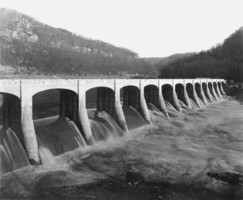
West Virginia’s streams have been harnessed for their energy since the days of early settlement. Countless gristmills and sawmills once crowded the banks of our creeks and rivers, many of them remaining in operation into the 20th century, and during the 19th century flowing water powered large factories on the Potomac and Shenandoah rivers at Harpers Ferry. By about 1900, water power was being used for the production of electricity in West Virginia. Although coal remains by far the most important fuel for electric generation in West Virginia, accounting for more than 91 percent of production in 2021, the production of hydroelectricity has slowly increased over the past century and more rapidly during the 21st century.
Hydroelectricity is produced by the capture of the energy of flowing water. Stream water is impounded by a dam to increase its ‘‘fall,’’ and thus its gravity power, then diverted to an electric generator. There, the rushing water spins the blades of a turbine to produce electric power.
Unlike the huge dams and power plants in the western United States, hydroelectric plants in West Virginia are smaller and usually situated on existing dams. These dams were built primarily for flood control and navigation, and sometimes refitted after many years for the production of electricity. Constructed in 1924–26, Cheat Lake is one of the few lakes in West Virginia created primarily for the production of electricity. The dam and power plant at Cheat Lake are located across the state line in Pennsylvania.
The Ohio, Cheat, Kanawha, Gauley, Potomac, Shenandoah, and New rivers have all been used in the production of electricity. Perhaps the best-known hydroelectric facility in the state, the 102-megawatt Hawks Nest-Gauley Bridge hydropower complex on the New River, is also associated with one of the nation’s worst industrial disasters. A tunnel was opened through Gauley Mountain to increase the fall of the water captured upstream at the dam. Construction of the three-mile tunnel began during the early years of the Great Depression, and hundreds of workers died from silicosis as the work progressed. The picturesque dam and lake are visible from Hawks Nest State Park, and the associated power plant is still in use after three-fourths of a century. The same company operated the nearby Glen Ferris dam and power plant, located at Kanawha Falls. Glen Ferris, the state’s oldest hydro complex, ceased generating electricity in 2002.
The production of hydroelectricity in West Virginia entered the 21st century in 2001, when the 80-megawatt power station on the Summersville Dam on Gauley River went into use. The plant is operated by the Gauley River Power Partners (acquired by Hull Street Energy in 2020), which includes the city of Summersville. Other hydropower plants include the 42-megawatt facility on the Ohio River at Belleville, which began producing electricity in 1999 and is operated by American Municipal Power. A similar partnership produces power on the Hannibal locks and dam on the Ohio River near New Martinsville, and others are in the planning stages for Bluestone Dam Dam in Summers County and R. D. Bailey Dam and Lake on the Wyoming-Mingo county line. These public private partnerships were made possible by the federal Public Utility Regulatory Policy Act, passed in 1978.
In 2021, hydro plants provided only a small fraction (2.5 percent) of all electricity generated in West Virginia; however, this was more than double the proportion (1.1 percent) produced at the beginning of the 21st century, although only a 15 percent increase in overall capacity. Most of the hydroelectricity in West Virginia is generated by independent producers, including projects on the Ohio River at New Martinsville and Belleville, which produce electricity primarily for sale, as well as for industrial producers, which themselves consume the power they generate. The electricity generated at Gauley Bridge, for example, is used by the parent company’s nearby ferrometals plant.
Hydroelectric plants now dot the major rivers of West Virginia, with installations at London, Marmet, Winfield, Gauley Bridge, New Martinsville, Summersville, and elsewhere. These plants are owned by the major electric utilities, as well as industrial and independent producers, but they are much smaller than the huge coal-fired electric plants. For example, Appalachian Power’s giant John E. Amos plant in Putnam County can produce 2,900 megawatts, nearly 10 times as much electricity as all hydroelectric plants in West Virginia combined. The Hawks Nest-Gauley Bridge complex, at 97 megawatts, is the largest producer of hydroelectricity in West Virginia.
Last Revised on July 18, 2023
Related Articles
Sources
U.S. Energy Information Administration. West Virginia: State Profile and Energy Estimates. U.S. Department of Energy. Washington, D.C.: U.S. Energy Information Administration, December 15, 2022.
Cite This Article
e-WV: The West Virginia Encyclopedia "Hydroelectricity." e-WV: The West Virginia Encyclopedia. 18 July 2023. Web. 22 October 2024.


Comments?
There aren't any comments for this article yet.
Click here to read and contribute to the discussion →